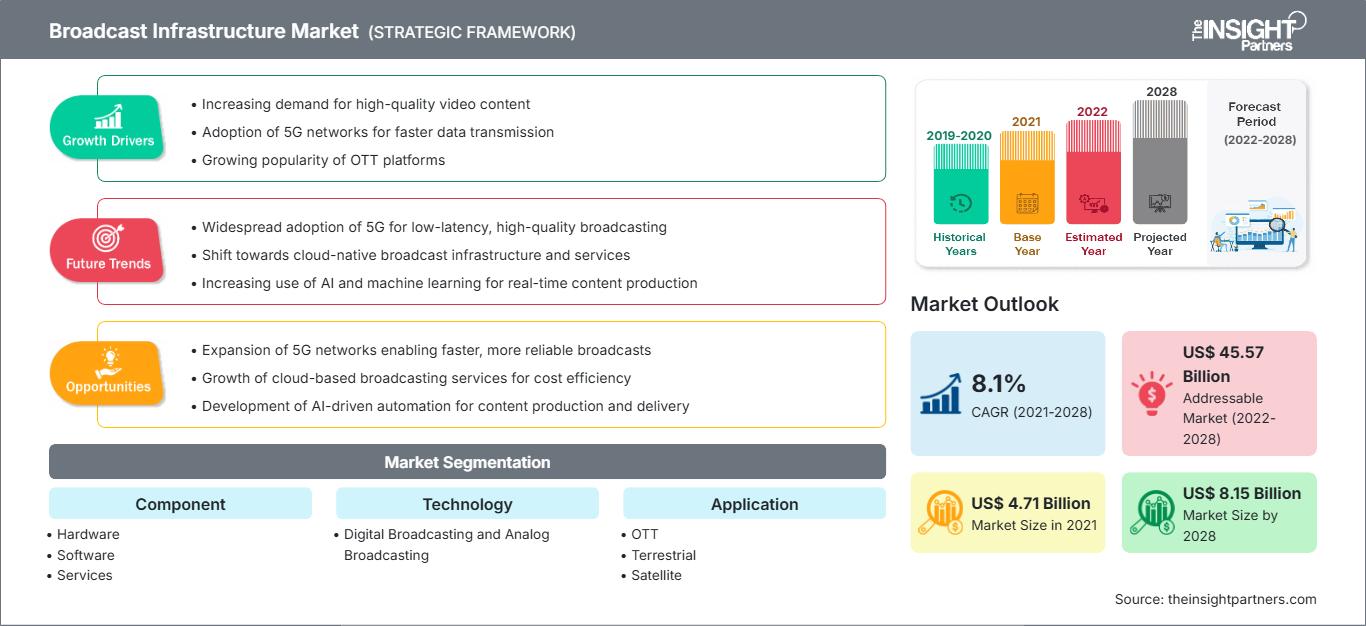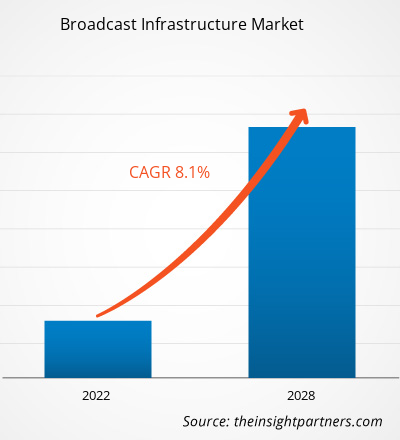[Research Report] The broadcast infrastructure market was valued at US$ 4,713.7 million in 2021 and it is projected to reach US$ 8,145.7 million by 2028; it is expected to grow at a CAGR of 8.1% from 2021 to 2028.
The paradigm shift of the broadcasting industry from analog to digital technology has introduced an advanced broadcast infrastructure, which is relatively complex. The broadcast industry is witnessing a significant demand for new broadcasting technologies such as internet protocol television (IPTV), web TV, high definition television (HDTV), and pay-per-view. The demand for enriched video experiences is expected to pave the way for broadcasters across the world, especially in Asia. Another key factor driving the broadcast infrastructure market is integrated platforms consisting of servers, set-top-boxes, and video content protection systems, along with appropriate tools, middleware, and billing, allowing the provision of a variety of TV services in several formats, such as video-on-demand, streaming, and time-shifted TV, based on a combination of underlying IP networks and DSL or optical access systems. Nowadays, vendors are moving from hardware-based infrastructure to software-based infrastructure due to the high cost of broadcasting hardware infrastructure, high maintenance cost, and frequent hardware upgrades. The broadcasting industry has been undergoing revolutionary innovations with technological developments to provide a better experience for users and creating an opportunity for the vendors of broadcast infrastructure.
Customize This Report To Suit Your Requirement
You will get customization on any report - free of charge - including parts of this report, or country-level analysis, Excel Data pack, as well as avail great offers and discounts for start-ups & universities
Broadcast Infrastructure Market: Strategic Insights

-
Get Top Key Market Trends of this report.This FREE sample will include data analysis, ranging from market trends to estimates and forecasts.
Impact of COVID-19 Pandemic on Broadcast Infrastructure Market
In the COVID-19 pandemic huge number of individuals are working from home and spending more time online and boasting the shift to digital. This demand for digital resources is further stressing the systems of several software and platform organizations and hindering their capability to serve services with reliability and quality. However, the COVID-19 outbreak has negatively impacted the players who are involved in delivering video content for the end users, owing to the shutdown of business and labor scarcity. The COVID-19 crisis also has drastically upended operations across the value chain, from supplier networks to the customer delivery experience due to business lockdowns, travel bans, and supply chain disruptions.
Market Insights – Broadcast Infrastructure Market
Increasing Adoption of New Broadcast Technologies
With continuous improvement in digitalization and an increase in disposable income, the market is witnessing a high adoption rate of IPTV and HDTV. The demand for enriched video experiences is expected to pave the way for broadcasters across the world, especially in Asia. The broadband proliferation is increasing across APAC, owing to the on-demand consumer viewing. Moreover, subscription-based over-the-top (OTT) platforms such as Netflix are gaining traction in Asia. Increased government spending on cloud-based infrastructure, cloud-based solutions and managed services, and hybrid networks is anticipated to boost the broadcast infrastructure market growth. Growing security concerns and maintaining customer trust will encourage broadcasters to adopt new delivery models. All the advancements and developments are likely to have a positive impact on the market growth during the forecast period.
Component-Based Insights
Based on component, the broadcast infrastructure market is segmented into hardware, software, and service. The software segment held the largest market share in 2020.
Broadcast Infrastructure Market Regional InsightsThe regional trends and factors influencing the Broadcast Infrastructure Market throughout the forecast period have been thoroughly explained by the analysts at The Insight Partners. This section also discusses Broadcast Infrastructure Market segments and geography across North America, Europe, Asia Pacific, Middle East and Africa, and South and Central America.
Broadcast Infrastructure Market Report Scope
| Report Attribute | Details |
|---|---|
| Market size in 2021 | US$ 4.71 Billion |
| Market Size by 2028 | US$ 8.15 Billion |
| Global CAGR (2021 - 2028) | 8.1% |
| Historical Data | 2019-2020 |
| Forecast period | 2022-2028 |
| Segments Covered |
By Component
|
| Regions and Countries Covered |
North America
|
| Market leaders and key company profiles |
|
Broadcast Infrastructure Market Players Density: Understanding Its Impact on Business Dynamics
The Broadcast Infrastructure Market is growing rapidly, driven by increasing end-user demand due to factors such as evolving consumer preferences, technological advancements, and greater awareness of the product's benefits. As demand rises, businesses are expanding their offerings, innovating to meet consumer needs, and capitalizing on emerging trends, which further fuels market growth.

- Get the Broadcast Infrastructure Market top key players overview
Players operating in the broadcast infrastructure market are mainly focused on the development of advanced and efficient products.
- In June 2021, EVS, the leading provider of live video technology for broadcast and new media productions, announced its partnership with Gravity Media to supply Xeebra multi-camera review system as the core technology for the company’s new integrated video adjudication and communications solution.
- In June 2021, Ross Video announced the acquisition of Primestream a Media-Asset workflow solution company. These solutions are used by customers within various market verticals, including enterprise, digital media, sports, and broadcast. Their solutions are designed to solve the unique and increasingly complex creative, business, and technology challenges in each market. Through this acquisition, Ross will naturally look to blend its Streamline media asset management solution with the Primestream products over time, to create a fully converged graphics and production asset management platform.
The broadcast infrastructure market has been segmented as follows:
Broadcast Infrastructure Market – by Component
- Hardware
- Software
- Services
Broadcast Infrastructure Market – by Technology
- Digital Broadcasting
- Analog Broadcasting
Broadcast Infrastructure Market – by Application
- OTT
- Terrestrial
- Satellite
- IPTV
- Others
Broadcast Infrastructure Market – by Geography
- North America
- US
- Canada
- Mexico
- Europe
- Germany
- France
- Italy
- UK
- Russia
- Rest of Europe
- Asia Pacific (APAC)
- Australia
- China
- India
- Japan
- South Korea
- Rest of APAC
- Middle East & Africa (MEA)
- Saudi Arabia
- UAE
- South Africa
- Rest of MEA
- South America (SAM)
- Brazil
- Argentina
- Rest of SAM
Broadcast Infrastructure Market – Company Profiles
- Cisco Systems, Inc.
- Clyde Broadcast Technology
- CS Computer Systems Ltd.
- Dacast Inc.
- EVS Broadcast Equipment SA
- Grass Valley
- Kaltura
- Nevion
- Ross Video Ltd
- Zixi
Frequently Asked Questions
Which country holds a dominating share in North America region?
Which are the major companies operating in the broadcast infrastructure market?
What are key driving factors behind broadcast infrastructure market growth?
Which region has dominated the broadcast infrastructure market in 2020?
What are key market opportunities for broadcast infrastructure market?
Which application dominated the market in 2020?
- Historical Analysis (2 Years), Base Year, Forecast (7 Years) with CAGR
- PEST and SWOT Analysis
- Market Size Value / Volume - Global, Regional, Country
- Industry and Competitive Landscape
- Excel Dataset
Recent Reports
Related Reports
Testimonials
Reason to Buy
- Informed Decision-Making
- Understanding Market Dynamics
- Competitive Analysis
- Identifying Emerging Markets
- Customer Insights
- Market Forecasts
- Risk Mitigation
- Boosting Operational Efficiency
- Strategic Planning
- Investment Justification
- Tracking Industry Innovations
- Aligning with Regulatory Trends





















 Get Free Sample For
Get Free Sample For